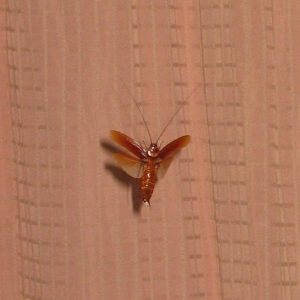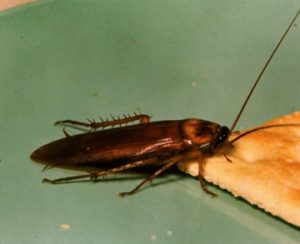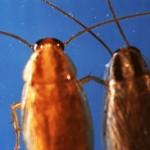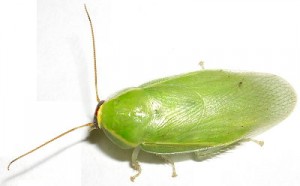 Roaches, a 350 million year old example of natures resiliency and ability to adapt. I have seen roaches in 120 degree attics, in moving vans, airplanes, gourmet kitchens, operating suites, grocery bags and in large commercial refrigerators huddling behind a beer box. In all cases they were alive and well and that doesn’t even come close to the full list. There are many different kinds of roaches that have adapted to live in specific but vastly different situations. The roach is the closest relative to termites in that they both digest cellulose. (wood). To rid roaches from your home,business or landscape you should first be able to identify your foe. Once you know what kind of roach you have you’ll have some inside information as to how and where to treat. Most roach species are happy to live outdoors and I guess we’re happy they do too. This post will deal with the occasional roach that wanders in.
Roaches, a 350 million year old example of natures resiliency and ability to adapt. I have seen roaches in 120 degree attics, in moving vans, airplanes, gourmet kitchens, operating suites, grocery bags and in large commercial refrigerators huddling behind a beer box. In all cases they were alive and well and that doesn’t even come close to the full list. There are many different kinds of roaches that have adapted to live in specific but vastly different situations. The roach is the closest relative to termites in that they both digest cellulose. (wood). To rid roaches from your home,business or landscape you should first be able to identify your foe. Once you know what kind of roach you have you’ll have some inside information as to how and where to treat. Most roach species are happy to live outdoors and I guess we’re happy they do too. This post will deal with the occasional roach that wanders in.
 The American Roach is a common critter that most of us in the states may see from time to time. They look a lot like the Australianbut lack yellow stripes down each side. It’s considered for the most part an occasional invader preferring outdoor living. Great fliers they will invade buildings through cracks, open windows, under loose door sweeps etc. They prefer areas of dampness, dark of course and feed on a wide variety of food. They are quite large, almost 2 inches at times but very quick and agile. A can of aerosol such as Raid usually zaps them and unless the exterior ‘pressure’ or population is such that you keep seeing more and more no further action is needed. If you do wish to eliminate them first start with exclusion. Seal up any areas (mentioned above) to keep them out. Outside the home you’ll want to remove any leaves that have built up or piles of debris, anywhere that they might hide and places that may store excess moisture. Usually a perimeter spray around the windows and door frames with such products as Demand CS or Talstar liquid are quite good as a barrier. A granular bait can also be broadcast around the base of the home or around any areas that can’t be ‘roach proofed’.(such as wood pile, dense shrubbery, etc.)
The American Roach is a common critter that most of us in the states may see from time to time. They look a lot like the Australianbut lack yellow stripes down each side. It’s considered for the most part an occasional invader preferring outdoor living. Great fliers they will invade buildings through cracks, open windows, under loose door sweeps etc. They prefer areas of dampness, dark of course and feed on a wide variety of food. They are quite large, almost 2 inches at times but very quick and agile. A can of aerosol such as Raid usually zaps them and unless the exterior ‘pressure’ or population is such that you keep seeing more and more no further action is needed. If you do wish to eliminate them first start with exclusion. Seal up any areas (mentioned above) to keep them out. Outside the home you’ll want to remove any leaves that have built up or piles of debris, anywhere that they might hide and places that may store excess moisture. Usually a perimeter spray around the windows and door frames with such products as Demand CS or Talstar liquid are quite good as a barrier. A granular bait can also be broadcast around the base of the home or around any areas that can’t be ‘roach proofed’.(such as wood pile, dense shrubbery, etc.)
Oriental Roaches, also called water bugs in the north and stink bugs(crush one for reason why) can be a nuisance indoors. They prefer dark moist areas such as your basement especially around sump pumps.  You can find them most around drains etc. where water is abundant or dampness prevails.
You can find them most around drains etc. where water is abundant or dampness prevails.
These behemoths do not fly but are quite adept at squeezing there way in small openings around windows and doors or through cracks in older cellar walls. The same type of treatment is needed with them as with the American Roach. For chronic problems run a de-humidifier in your basement or do anything else you can to reduce moisture. These guys also love Niban granular baits. Sprinkle some where safe or place in a small box with a hole cut out for entry. They’ll find it.
Other roaches also known as occasional invaders that would require similar treatment would be.
Australian Roach, another great flyer and is very similar to the American in terms of eating habits . Treat as you would for the American Roach.
Palmetto Roach, Florida version of the Water bug mainly nestles in damp leaf debris and in the native palm trees, Such as, you guessed it, the Palmetto. Same treatment as the Water bug.
Cuban Roach, really rare inside, flies quite well and is a beauty as far as roaches go. (not this big I just wanted to show you a ‘pretty’roach) No treatment needed.
Asian Roach, quite the pain in the southeast. Able to fly very well and is attracted to lights. Your best tool for this guy is a rake. Take a moment to view any standing leaf pile in the south and once focused you’ll see hundreds of Asian Roaches. Reduce the leaves and yo u’ll reduce the roach. Also of note; The Asian Roach looks remarkably like the German Roach. Visibly the only difference is the stripes on the pronotum. The Asian Roachesstripes are darker. For those found indoors a thorough treatment using residual sprays will suffice. Suspend SC or Demand will do nicely but you’ll do better with an outdoor spray and bait approach. (after raking) Bifen I/T in a back pack sprayer around entry points and Niban FG in the grassy areas around the home and areas of leaf or organic debris build up should help a great deal.
u’ll reduce the roach. Also of note; The Asian Roach looks remarkably like the German Roach. Visibly the only difference is the stripes on the pronotum. The Asian Roachesstripes are darker. For those found indoors a thorough treatment using residual sprays will suffice. Suspend SC or Demand will do nicely but you’ll do better with an outdoor spray and bait approach. (after raking) Bifen I/T in a back pack sprayer around entry points and Niban FG in the grassy areas around the home and areas of leaf or organic debris build up should help a great deal.
Surinam Roach, is also rare inside the home. Whenever I’ve found them indoors they’ll always been ‘belly up’. You shouldn’t need to treat inside except in rare occasions. This roach prefers it outside and usually can be found around wood piles, fallen logs or in heavily wooded areas. They are strong fliers and mostly nocturnal (as are most roaches). A perimeter spray using Bifen I/T as well as a layer of the Niban FG granules and you’ll be set. Perhaps shake some Niban around wood pile or any heavily mulched area for the finishing touch.
Treatment for all of these is fine but sometimes not completely necessary. It may be as simple as raking and removing leaves or turning off a dripping spicket will do wonders in keeping wandering roaches from venturing to close. Keep garbage cans covered and clean, pet food as well should be sealed up if stored say in the garage. Sealing doors and yellow light bulbs help tremendously as well. If you have a rather large population in your home look for favorable conditions such as these and correct them. You’ll be surprised how quickly things subside. Roaches such as the Surinam or Cuban roach are so rare inside that you should employ no control at all. Maybe take a picture cause none of your friends will believe you saw a ‘green’ roach. Sometimes populations do get out of control and you will need to treat. But for the most part just let natures little recyclers do their thing.
Outside of course!
Do you have certain roaches that occasionally invade not listed here? Let me know. Simply post a comment below and I’ll be happy to update the list and share tips on their control.






